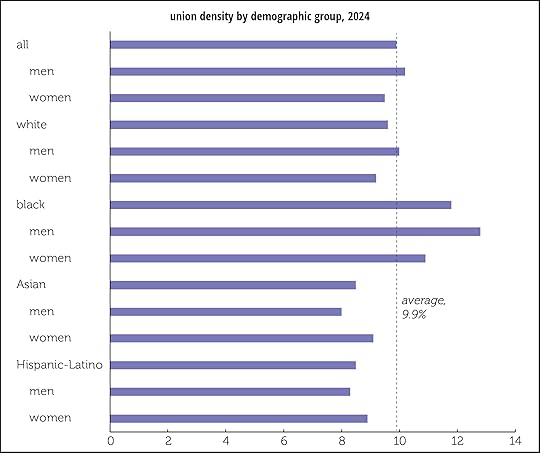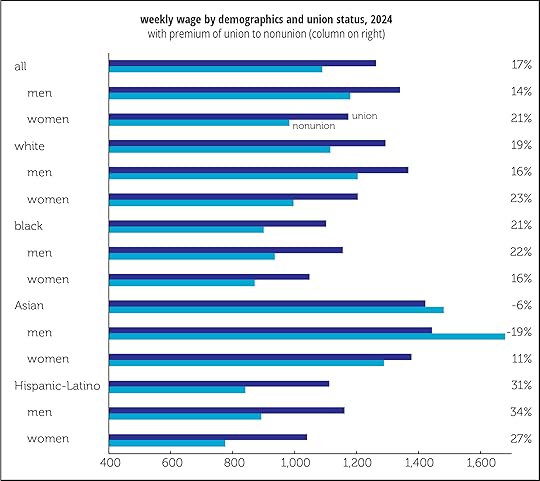More on union density: who and where
A follow-up to yesterday’s post about historical trends in union density. Today, a look at demographics and geography.
Once upon a time, the stereotypical union member was a factory worker. That hasn’t been the case for a long time. In 2024, manufacturing accounted for 10% employment and only 8% of union membership. In 1983, the numbers were very different: 22% of employment and 30% of union membership. Last year, not quite 8% of manufacturing workers were unionized—higher than private services, where it’s under 6%—but that’s down hard from 28% in 1983.
demographicsThat modal union member of the mind was also typically male. No longer. Last year, 10.2% of male workers were unionized, not much higher than the 9.5% among women. And notional modal member was often white too. As the graph below shows, union density is higher among black Americans than any other racial/ethnic group.

Unions also narrow pay gaps among disfavored groups (graph below). The union premium is higher for women than men, for Hispanics/Latinos and for black workers than for whites (see the column on the right for details). Unions narrow the black/white weekly wage gap by 4 percentage points and the Hispanic–Latino/white gap by 6 (not graphed, sorry). Sadly, that advantage has been narrowing over time as unions weaken, but it’s still significant.

Union density rates vary widely by state, from North Carolina’s 2.4% to Hawaii’s 26.5%. Details are mapped below.

High-density states are concentrated in the Northeast, the upper Midwest, the West, and offshore. The South is low-union land: of the ten states with a density under 5%, seven are in the South. As I noted yesterday, union density in the states of the former Confederacy averaged 4.3% last year. It averaged 10.9% outside the Confederacy—well over twice as much. W.E.B. Du Bois’s descriptions of the Southern labor market in Black Reconstruction sound quite familiar today.
codaI usually end these density writeups with a homily. The union premium may be declining, but any premium >0% will inspire bosses to hate unions and want to destroy them—and not just for the higher pay. Unions are a constraint on bosses’ behavior; they can force them to be less racist, less abusive, and less able to fire. But clearly they’ve lost a lot of their bite over time.
And now my standard conclusion:
There are a lot of things wrong with American unions. Most organize poorly, if at all. Politically they function mainly as ATMs and free labor pools for the Democratic party without getting much in return. But there’s no way to end the 40-year war on the US working class without getting union membership up….
It’s still true, though I’ve got to up that count to 45 years or more.
Doug Henwood's Blog
- Doug Henwood's profile
- 30 followers



